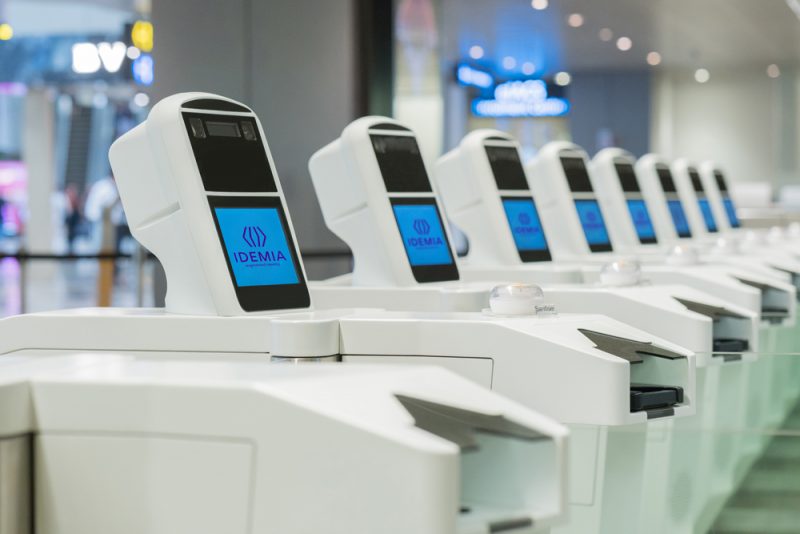Richard Mikhael, president MEA of security firm IDEMIA, discusses how airports can secure borders with contactless biometric technology.
In an effort to “flatten the curve” and curb the spread of Covid-19, countries around the world implemented border closures.
The economic pain that ensued from the border closures, coupled with some recent gains at controlling the spread of the virus, have led to countries gradually opening their borders again in the hope of restarting the engines for their economies.
But herein lies the conundrum: in addition to the need of security at borders and seamless traveller experience, they must now ensure a safer and more hygienic environment for both airport employees and travellers.
To achieve this, airports have implemented additional sanitation measures such as social distancing, enhanced sanitation cycles and temperature checks. Airports in both Abu Dhabi and Dubai require travellers to wear face masks and gloves to ensure that contamination risks from ambient water droplets and surfaces are kept to a minimum.
Minimizing the risk of infection at the point of entry/exit is fundamental to rebuild traveller confidence, a direct contributor to stimulate the travel industry. At the recent FTE (Future Travel Experience) APEX Airports virtual event, Dr Joe Leader, CEO of APEX and IFSA, stated that he believes airports will be “critical in setting the tone for safe passenger travel in a post Covid-19 world”.
In particular, Dr Leader highlighted that extra vigilance is a top priority for airport security areas as they are used by “hundreds, and perhaps thousands of people daily”.
Further proving his point, Abu Dhabi Airport has put out a video documenting the sanitation measures from the moment travellers arrive at the airport to the time when they board the flight.
It is worth noting that ‘contactless’ is highlighted throughout the video: travellers are temperature-checked via thermal scanners, identified and traced via wearable technology, such as Google Glass, and border crossings enabled with contactless biometric technology.
As a veteran of border security, this does not surprise me. Contactless biometric technology for border control has been gaining popularity within the industry. In 2017, The Australian Department of Immigration and Border Protection tried a contactless biometric authentication technology that would remove the need for a known traveller to present a physical passport in Australian airports.
Recently, the country rolled out its new Enterprise Biometric Identification Services (EBIS) system, which will serve as the backbone for processing border clearances for legitimate travellers, just in time for its reopening. A core of the EBIS system is its facial biometric matching solution, supplied by IDEMIA.
A frontrunner in adopting innovative technology, the UAE is no stranger to leveraging contactless technology for enhancing border security. As early as 2015, Abu Dhabi started on its e-Border project, integrating contactless biometric technology, automation and system integration to secure the country’s borders.
The e-Border project was also amongst the first in the world to spearhead iris and face recognition for border control with Iris-at-a-Distance (IAD) cameras. As opposed to touch-based scanners, the IAD cameras offer speed and accuracy, with its ability to capture iris and face simultaneously in under two seconds, and mitigate any hygiene concerns for travellers.
Contactless biometric technology is also supporting Dubai’s Terminal to process travellers in a fast, accurate and safe manner. Leveraging IDEMIA’s OneLook multi-biometric solution, the border protection officers can effectively process legitimate travellers behind plexi-glass panels that are installed to protect their health and safety.
It would, however, be short-sighted to think that contactless biometric technology is limited to high security areas such as passport clearance. In fact, contactless biometric technology should be thought of as the way forward to achieve a secured, hygienic and seamless travel experience.
Contactless biometric technology can be incorporated at the very beginning of the travel process – at traveller check-in. In today’s context, where all travellers are required to wear face masks inside the airport, authenticating and verifying travellers with their iris would be an ideal solution to protect both the airport’s employees and travellers.
Contactless biometric technology can also be used with contactless fingerprint scanners, for instance, at self-service kiosks that are present at immigration pre-checks. Incorporating contactless biometric technology in place of physical touchpoints around the airport, even at duty free, would have an added travel advantage of eliminating the need to keep showing an ID document at every turn.
This achieves a more seamless experience and ease of mind (for those of us who fear losing our documents within the airport) even before we board the aeroplane.
In addition to securing borders, the pandemic has spotlighted the important role that key infrastructures such as an airport, have to play in protecting both travellers and employees.
Contactless biometric technology looks set to be a fundamental part of this equation with its ability to protect all airport employees and travellers, from the airport curb to boarding.
About Guide2Uganda
Guide2Uganda (www.guide2uganda.ug) is the most comprehensive source of information about Uganda that exists on the web, with more content on Uganda and surrounding towns, attractions, museums and galleries than any other online guide that currently exists for Uganda as well as being a dynamic news and comprehensive events driven site with content being added daily.
According to WeFollow & Peer Index (whom both measure online influence) we are among the most influential online media organizations in Uganda. We were also awarded for ‘’Best Destination Website in Uganda’’ by Jumia Travel Uganda in the 2017-2018 Africa Travel Awards. If you are planning a visit to Uganda you can always reach us on; info@guide2uganda.ug




